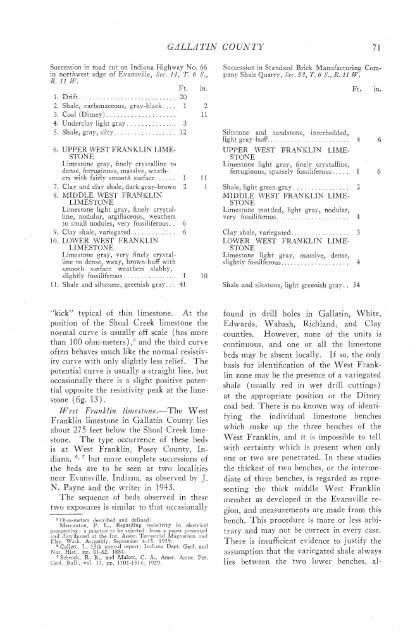subsurface geology and coal resources of the pennsylvanian system ...
subsurface geology and coal resources of the pennsylvanian system ...
subsurface geology and coal resources of the pennsylvanian system ...
You also want an ePaper? Increase the reach of your titles
YUMPU automatically turns print PDFs into web optimized ePapers that Google loves.
GALLA TIN<br />
Succession in road cut on Indiana Highway No. 66<br />
in northwest edge - <strong>of</strong> Evansville, Sec. 14, T. 6 S.,<br />
I1 W.<br />
Ft. in.<br />
Drift. ........................... 20<br />
Shale, carbonaceous, gray-black. ... 1 2<br />
Coal (Ditney) ....................<br />
Underclay light graj7. ............. 3<br />
11<br />
Shale, gray, silty.. ................ 12<br />
UPPER WEST FRANKLIN LIME-<br />
STONE<br />
Limestone gray, finely crystalline to<br />
dense, ferruginous, massive, wea<strong>the</strong>rs<br />
with fairly smooth surface .... 1<br />
Clay <strong>and</strong> clay shale, dark gray-brown 2<br />
MIDDLE WEST FRANKLIN<br />
LIMESTONE<br />
Limestone light gray, finely crystalline,<br />
nodular, argillaceous, wea<strong>the</strong>rs<br />
to small nodules, very fossiliferous. . 6<br />
Clay shale, variegated.. ........... 6<br />
LOWER WEST FRANKLIN<br />
LIMESTONE<br />
Limestone gray, very finely crystalline<br />
to dense, waxy, brown-buff with<br />
smooth surface wea<strong>the</strong>rs slabby,<br />
slightly fossiliferous ............... 1<br />
Shale <strong>and</strong> siltstone, greenish gray. .. 41<br />
11<br />
1<br />
10<br />
COUNTY 71<br />
Succession in St<strong>and</strong>ard Brick Manufacturing Company<br />
Shale Quarry, Sec. 92, T. 6 S., R. 11 W.<br />
Ft.<br />
Siltstone <strong>and</strong> s<strong>and</strong>stone, interbedded,<br />
light gray-buff.. ...................... 4 6<br />
UPPER WEST FRANKLIhT LIME-<br />
STONE<br />
Limestone light gray, finely crystalline,<br />
ferruginous, sparsely fossiliferous. .... 1 6<br />
Shale, light green-gray. ............... 2<br />
MIDDLE WEST FRANKLIN LIME-<br />
STONE<br />
Limestone mottled, light gray, nodular,<br />
very fossiliferous ..................... 4<br />
Clay shale, variegated.. ............... 3<br />
LOWER WEST FRANKLIN LIME-<br />
STONE<br />
Limestone light gray, massive, dense,<br />
slightly fossilferous. ................... 4<br />
Shale <strong>and</strong> siltstone, light greenish gray. . 54<br />
in.<br />
"kick" typical <strong>of</strong> thin limestone. At <strong>the</strong><br />
position <strong>of</strong> <strong>the</strong> Shoal Creek limestone <strong>the</strong><br />
normal curve is usually <strong>of</strong>f scale (has more<br />
than 100 ohm-meters) ,%nd <strong>the</strong> third curve<br />
<strong>of</strong>ten behaves much like <strong>the</strong> normal resistivity<br />
curve with only slightly less relief. The<br />
potential curve is usually a straight line, but<br />
occasionally <strong>the</strong>re is a slight positive potential<br />
opposite <strong>the</strong> resistivity peak at <strong>the</strong> limestone<br />
(fig. 13).<br />
West Franklin 1irnestone.-The West<br />
Franklin limestone in Gallatin County lies<br />
about 275 feet below <strong>the</strong> Shoal Creek limestone.<br />
The type occurrence <strong>of</strong> <strong>the</strong>se beds<br />
is at West Franklin, Posey County, Indiana,<br />
'> but more complete successions <strong>of</strong><br />
<strong>the</strong> beds are to be seen at two localities<br />
near Evansville, Indiana, as observed by J.<br />
N. Payne <strong>and</strong> <strong>the</strong> writer in 1943.<br />
The sequence <strong>of</strong> beds, observed in <strong>the</strong>se<br />
two exposures is similar to that occasionally<br />
5 Ohm-meters described <strong>and</strong> defined :<br />
Mercanton, P. .L., Regarding resistivity in electrical<br />
prospecting; a practlce to be rejected: from a paper presented<br />
<strong>and</strong> diqtributed at <strong>the</strong> Int. Assoc. Terrestrial Magnetism 2nd<br />
IXlec. Wash. Assembly. September 4-1 5. 1939.<br />
a Collett, J., 13th annual report: Indiana Dept. Geol. <strong>and</strong><br />
Nat. I-Iist., pp. 61-62, 1884.<br />
7 Schrock, R. R., <strong>and</strong> Malott, C. A., Amer. Assoc. Pet.<br />
Geol. Bull., vol. 13, pp. 1301-1314, 1929.<br />
found in drill holes in Gallatin, White,<br />
Edwards, Wabash, Richl<strong>and</strong>, <strong>and</strong> Clay<br />
counties. However, none <strong>of</strong> <strong>the</strong> units is<br />
continuous, <strong>and</strong> one or all <strong>the</strong> limestone<br />
beds may be absent locally. If so, <strong>the</strong> only<br />
basis for identification <strong>of</strong> <strong>the</strong> West Franklin<br />
zone may be <strong>the</strong> presence <strong>of</strong> a variegated<br />
shale (usually red in wet drill cuttings)<br />
at <strong>the</strong> apprcpriate position or <strong>the</strong> Ditney<br />
<strong>coal</strong> bed. There is no known way <strong>of</strong> identifying<br />
<strong>the</strong> individual limestone benches<br />
which make up <strong>the</strong> three benches <strong>of</strong> <strong>the</strong><br />
West Franklin, <strong>and</strong> it is impossible to tell<br />
with certainty which is present when only<br />
one or two are penetrated. In <strong>the</strong>se studies<br />
<strong>the</strong> thickest <strong>of</strong> two benches, or <strong>the</strong> intermediate<br />
<strong>of</strong> three benches, is regarded as representing<br />
<strong>the</strong> thick middle West Franklin<br />
member as developed in <strong>the</strong> Evansville region,<br />
<strong>and</strong> measurements are made from this<br />
bench. This procedure is more or less arbitrary<br />
<strong>and</strong> may not be correct in every case.<br />
There is insufficient evidence to justify <strong>the</strong><br />
assumption that <strong>the</strong> variegated shale always<br />
lies between <strong>the</strong> 1 x 7 0 lower benches, al-
















